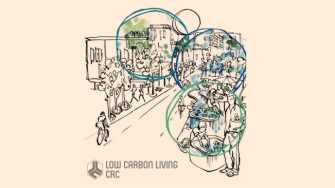Program 1: Integrated Building Systems

Despite world-class products being manufactured in Australia, cool roof technology is, as yet, greatly under-utilised both locally and internationally.
Large-footprint buildings provide a significant opportunity for market penetration of local cool roof technologies, which will open up the cool roof market more generally; as long as the current barrier of lack of rigorous evidence and design information can be overcome.
Building energy modelling software packages, for example, greatly under-predict the benefit of cool roofs on large-footprint buildings because they do not account for the significant negative impact of the ‘heat-bubble’ that develops above a normal (non-reflective) roof in summer. The elevated temperatures in such heat-bubbles (or building-scale heat islands, BSHIs) significantly reduce the performance of roof-mounted cooling plant. The removal of this detrimental impact through use of cool roof products is likely to result in an even greater decrease in building energy use than through the ‘passive’ impact of the cool roof reducing heat flow through the roof structure into the building.
The project will deliver:
a) a comprehensive set of cool roof design and cost-benefit calculation resources, focussed on typical large-footprint Australian buildings; and
b) a rigorous experimental and simulation evidence-base of the impact of cool roof products on building thermal performance and the characteristics of the building-scale heat island above large-footprint buildings.
Prof. Paul Cooper, University of Wollongong
Complete
10/2019
- Publications
- Partners
CRCLCL Presentations
RP1037: Conference paper: Near-Roof Air Temperatures: Modelling the Implications for HVAC Performance and Cool Roofs
Conventionally in building performance simulations (BPS), it is assumed that air entering outdoor HVAC equipment is at the outdoor ‘ambient’ temperature, obtained from a weather file. However, significant spatial variations exist in outdoor air temperature fields, especially within the thermal boundary layers that form near exposed surfaces like roofs.
Experiments were conducted at three large-footprint shopping centre buildings, to characterise the above-roof temperature field. An empirical model was derived from the experimental data, and applied in BPS of a shopping centre with rooftop HVAC equipment in seven Australian climates. In these cases, the electricity savings and gas ‘penalties’ attributable to cool roofs would have been underestimated by 44–85% (61% on average) if near-roof air temperature variations had not been modelled accurately.
This paper will be presented at Building Simulation 2019, Rome, 2-4 September 2019.
Near-Roof Air Temperatures: Modelling the Implications for HVAC Performance and Cool Roofs (753500 PDF)
RP1037: Conference Presentation: Characterisation of the air temperature field about large-footprint buildings - full-scale experiments and large eddy CFD simulations
ahmtc paper rp1037 cool roofs 1 (2159153 PDF)
CRCLCL Project Reports
Driving Increased Utilisation of Cool Roofs on Large Footprint Buildings - Final Report
This is the final report for the Driving Increased Utilisation of Cool Roofs on Large Footprint Buildings project, providing case studies about how cool roof technology reduces the amount of heat transmitted into buildings on hot days, and in turn the amount of air-conditioning required for cooling.
rp1037 final report 9 9 2018 (7864003 PDF)
Fact Sheet
RP1037 FACTSHEET: Cool roofs: Your roof materials can improve the efficiency of solar panels and air-con
Cool roofs use roofing materials with high solar reflectance and thermal emittance, reducing the heat absorbed from the sun and increasing the heat radiated out to the sky. Cool roof technology reduces the amount of heat transmitted into buildings on hot days, and thus the amount of air-conditioning required for cooling. Their widespread use across a neighbourhood or precinct can mitigate the urban heat island effect.
factsheet rp1037 final (582162 PDF)